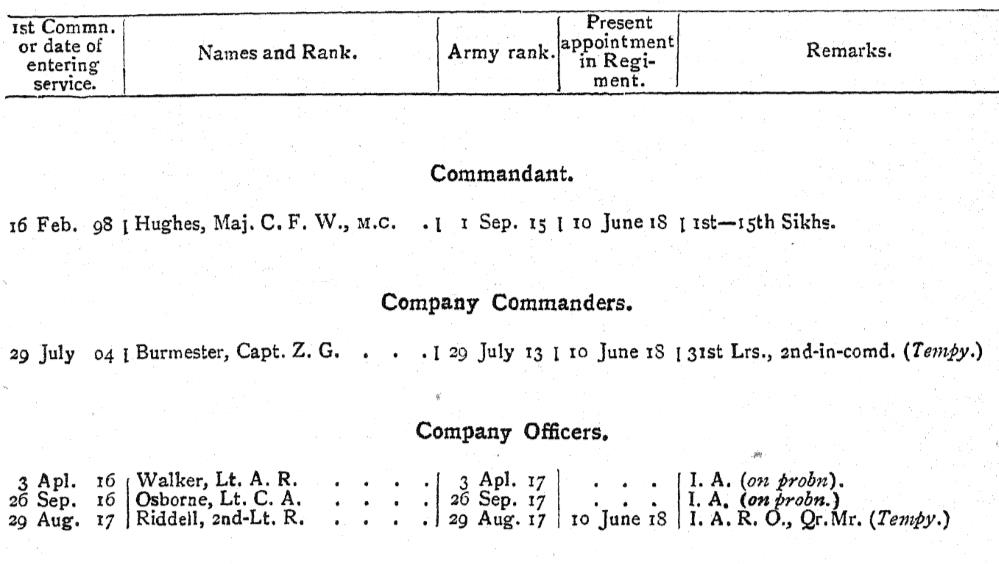This article is about the short-lived 2nd Battalion 15th Ludhiana Sikhs and will help you to research the Battalion and the soldiers who served with it during the First World War. I have written a separate article about the 1st Battalion 15th Ludhiana Sikhs and a series of guides to help you to research soldiers who served in the Indian Army during the First World War. To view the guides click on the blue links below:
The 2nd Battalion 15th Ludhiana Sikhs in the First World War
Lineage: The 2nd Battalion 15th Ludhiana Sikhs was formed at Hyderabad, Sind (Sindh, Pakistan), on 6 June 1918 and was disbanded on 3 November 1921. For a history of the Regiment’s lineage see my page on the 1st Battalion 15th Ludhiana Sikhs.
Class Composition of Battalion in 1919: 2 Companies of Sikhs and 2 of Punjabi Muslims.
The 2nd Battalion 15th Ludhiana Sikhs was a short-lived Indian infantry Battalion raised at Hyderabad (Sindh, Pakistan) on 6 June 1918. Despite its name, and unlike the 1st Battalion, the 2nd Battalion was composed of 2 companies of Sikhs and 2 companies of Punjabi Muslims. The split represented the increasing difficulty the Indian Army had in finding Sikh recruits after nearly 4 years of war. During its brief existence, the Battalion served with the 4th (Quetta) Division. The extract below was taken from the July 1918 Indian Army List and records the British officers which were serving with the Battalion. As the Battalion had only been formed the month before, it only had 5 British officers and 5 Indian officers.
The Battalion was initially commanded by Major Charles Frederick Watson Hughes, a long-serving officer who was appointed from the 1st Battalion 15th Ludhiana Sikhs on 10 June 1918. The Battalion was first inspected in December 1918 by Major-General Francis John Fowler and received “A very satisfactory report.”, the highest the grade. Due to the paucity of sources for the Battalion I have quoted the report at length:
Considering its youth, the battalion is in a very satisfactory state. Started on a good nucleus from the first battalion its commanding officers have organised its training on sound lines and it promises to be fit for service in eight months time.
The turnout of the battalion is, considering its youth, very creditable. The personnel are good and their discipline satisfactory. Their health is also good. The sound interior economy of this new formation reflects great credit on the officer who raised it.
The satisfactory progress made by this unit shows what can be done by good officers under favourable conditions. Starting with an excellent nucleus of a company from the 1-15th Sikhs the battalion has progressed steadily and rapidly in its training, and its interior economy has developed on sound lines.
Few units will reach a satisfactory state of war efficiency in so short a time.
Confidential review reports on Indian Army units, depots, British officers, etc. for 1918-1919: IOR/L/MIL/7/17030
The Battalion was inspected again in January 1920, where it received a less than favourable report. It was noted that the Battalion, “Has been greatly handicapped as it has had 9 moved since 1918. This has greatly interfered with training”. During 1919 training season, the Battalion was employed on rail defence. The 2nd Battalion 15th Sikhs was disbanded on 3 November 1921.
War Diaries of the 2nd Battalion 15th Ludhiana Sikhs
Unfortunately, there are no war diaries for the 2nd Battalion 15th Sikhs.
Further Sources for the 2nd Battalion 15th Sikhs
Information regarding the British and Indian officers who served with the 2nd Battalion 15th Sikhs can be found by consulting the Indian Army List. Confidential reports for the regiment are held at the British Library: Confidential review reports on Indian Army units, depots, British officers, etc. for 1918-1919: IOR/L/MIL/7/17030 and Confidential review reports on Indian Army units, depots, British officers, etc. for 1919-1920: IOR/L/MIL/7/17031. These confidential reports also contain the annual reports of the British officers serving with the Battalion.

